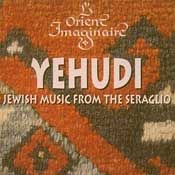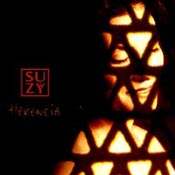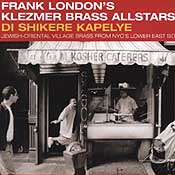L'Orient Imaginaire | Frank London's Klezmer Allstars
Shaatnez

Michael Stone Looks at Jewish Music from the Interzone
In vernacular Hebrew, the term shaatnez refers derogatorily to the blending of things that do not belong together. But so it is with Jewish musics a propensity for cultural borrowing and synthesis, a historical artifact of sustained transcultural exposure, the very antithesis of cultural isolation and marginality. Indeed, a broad mix of contemporary classical, pop and revival musicians and audiences has taken up, nourished and adapted both Eastern European klezmer and Sephardi (Ladino or Judeo-Spanish) music in a variety of historical, geographical, sociological and political settings. This process of musical interdependence reveals a distinct capacity to transit cultural frontiers, moving through a dynamic "interzone" where diverse groups may interact, at least in aesthetic terms, without surrendering (and actually, often enhancing) a unique sense of cultural identity.
Weighing the seeming paradox of Mizrahi (Arab or �Oriental� Jewish) music's growing popularity with Palestinian and Egyptian audiences, anthropologist Ted Swedenburg proposes the interzone metaphor to comprehend the hybrid cultural dynamics of musical exchange. He suggests parallels with North African-Andalusian music's popularity in western Europe and beyond, and the transnational convergence of artists and audiences evident in the vibrant French hip-hop scene. To illustrate, he cites the genre-bending transglobal popularity of such Mizrahi artists as Dana International, Alabina, Zehava Ben, San Francisco-based DJ Cheb I Sabbah, and (on her father's side, at least) Natacha Atlas. By extension, the interzone concept seems useful to understand the remarkable diversity of contemporary Jewish musical expressions, as heard on several recent releases.
 L'Orient Imaginaire's Yehudi: Jewish Music from the Seraglio (Teldec Classics International) adroitly explores the contributions of professional Sephardi musicians and composers to the meditative spirit of Turkish art music in the seraglio (sultan's court) from the 18th century until the 1918 Ottoman collapse. Vladimir Ivanoff, the group's musical director, is a musicologist, lutenist and percussionist (he also founded the Sephardi roots group Ensemble Sarband). L'Orient Imaginaire's other five male members, all Turkish with conservatory training, comprise a classical Ottoman ensemble of ud (short-necked lute), ney (end-blown reed flute), kanun (zither), kemençe rumi (Greek or Anatolian violin), kudüm (kettle drums), percussion and vocals. Perhaps an unconscious expression of patriarchy, there is, alas, no information on the accompanying female vocalists, but Ivanoff's notes do outline Sephardi history, the role and influence of Jewish seraglio musicians and composers, and their mastery of Turkish modes, song forms and instrumentation. Yehudi (the Ottoman term for Jew) is an accomplished and meditative scholarly exploration of Jewish seraglio music.
L'Orient Imaginaire's Yehudi: Jewish Music from the Seraglio (Teldec Classics International) adroitly explores the contributions of professional Sephardi musicians and composers to the meditative spirit of Turkish art music in the seraglio (sultan's court) from the 18th century until the 1918 Ottoman collapse. Vladimir Ivanoff, the group's musical director, is a musicologist, lutenist and percussionist (he also founded the Sephardi roots group Ensemble Sarband). L'Orient Imaginaire's other five male members, all Turkish with conservatory training, comprise a classical Ottoman ensemble of ud (short-necked lute), ney (end-blown reed flute), kanun (zither), kemençe rumi (Greek or Anatolian violin), kudüm (kettle drums), percussion and vocals. Perhaps an unconscious expression of patriarchy, there is, alas, no information on the accompanying female vocalists, but Ivanoff's notes do outline Sephardi history, the role and influence of Jewish seraglio musicians and composers, and their mastery of Turkish modes, song forms and instrumentation. Yehudi (the Ottoman term for Jew) is an accomplished and meditative scholarly exploration of Jewish seraglio music.
Also in classical mode, Júlia Füzfa sings a variety of Jewish folkloric songs in Hungarian, Yiddish, Hebrew and Ladino (the Spanish-Sephardi language). Backed by pianists Ferenc Jávori and Csaba Király, Füzfa's performance on I'm a Slave to Your Beauty: Sepharadi, Yiddish & Hebrew Songs (Hungaroton Classic) reflects her conservatory training at Budapest's Ferenc Liszt Academy of Music. The Ladino songs, including the title track, echo the free-flowing Moorish melodies and longing of the Spanish romanza or love song. The Yiddish songs show German, Slavic and gypsy folk influences absorbed by Eastern European Jewish musicians, and the lively Hassidic strains that animate klezmer dance music. Füzfa also performs several examples of Hungarian-Jewish music, a distinctive expressive vein that cultural leaders deliberately crafted as Hungarian Jews were expelled from public life early in the 1940s. These Hebrew songs invoke the spirit of Jewish renaissance and Zionist return that emerged at the end of the 19th century. Among them, listeners may recognize "Yerushalayim Shel Zahav" ("Golden Jerusalem") from the labor camp liberation scene at the close of Shindler's List.
In an earlier chapter of exile, to encourage devotion and counter the adverse effects of foreign cultural influence on Jewish congregations, Sephardi cantors and payyetan (religious musical poets) in Moorish Andalusia composed liturgical music by setting Hebrew devotional texts to the melodic, metrical, vocal and instrumental forms of popular Arab song. Expelled from the Iberian peninsula in 1492, the Sephardim carried their music to North Africa, the Levant, the Balkans, northwestern Europe and the New World.
North African Sephardi communities sustained Ladino musical traditions amidst their Muslim counterparts well into the 20th century. There, cantors and payyetan continued to nurture the Andalusian-Hebrew a cappella liturgical tradition. Twentieth Century Moroccan recordings reveal that the Sephardim developed northern and southern regional variations of piyyutim (religious poetic) song, and introduced northern European and Ashkenazi melodic influences by way of contact with Sephardi communities in France. Concurrently, Sephardi artists and composers continued to adapt modern Hebrew texts to popular North African (especially Egyptian) modes and songs.
 Sacred Music of the Moroccan Jews (Rounder), a two-CD edited collection of 1959 field recordings by writer Paul Bowles, documents several North African Ladino sacred musics. The first disc presents an evening synagogue service marking the Sabbath's conclusion in Meknes. Singers supplement the standard liturgical text by inserting piyyutim throughout the service, which alternates male solo vocals with the congregation's sung prayers. Most sociologically instructive
Sacred Music of the Moroccan Jews (Rounder), a two-CD edited collection of 1959 field recordings by writer Paul Bowles, documents several North African Ladino sacred musics. The first disc presents an evening synagogue service marking the Sabbath's conclusion in Meknes. Singers supplement the standard liturgical text by inserting piyyutim throughout the service, which alternates male solo vocals with the congregation's sung prayers. Most sociologically instructive
"El hay ram gadol" |
"Norten la-ya'af" (Meknes) |
The Bowles recordings are especially important because they document the Andalusian Hebrew traditions of Morocco just prior to the mass exodus of Moroccan Jews to Israel and Europe (a vibrant Jewish community persists in Casablanca). North African decolonization in the 1960s sent some Sephardim to France, where they joined established communities. There, percussionist and folklorist Pierre-Luc Ben Soussan collected Sephardi devotional songs and recruited Montpellier cantor André Taïeb, violinist Mohamed Zeftari, and Kamal Berrada (ud, ney) to form the Naguila Ensemble. Chants Mystiques Séfarades, a keenly meditative album, reveals the abiding musical relationship between the expressive cultural legacies of North Africa and Spain, as distilled through the Sephardi experience. Morocco-born mawal singer Emil Zrihan, presently cantor of the main synagogue in Ashkelon, Israel, is a contemporary exponent of Judeo-Moroccan music who has gained an international audience. Another enduring denizen of the global musical interzone, Algerian Jewish pianist Maurice El Médioni combines North African, Andalusian, Jewish, Cuban and western jazz and pop influences with his own daunting keyboard technique. Backed by the Klezmatics' David Krakauer on clarinets and Frank London on trumpet, bassist Sabah Habas Mustapha (of 3 Mustaphas 3), Nubian percussionist Mahmoud Fadl and drummer Marco Maimaran, El Médioni's piano provides a transcendent vehicle for the incomparable vocal work of Michel Rebibo. (Recordings by the Naguila Ensemble, Zrihan and El Médioni are reviewed elsewhere in RootsWorld.)
 In Israel, North African Sephardim came into contact with Ladino-speaking immigrants from Turkey, Greece and the Balkans. Turkish-born SuZy's singing career grew out of an informal effort to record for her children the Ladino lullabies her grandmother and aunt sang to her. The resulting cassette circulated informally among Israeli Sephardim and eventually found its way into the industry realm. World music compilations released in Israel, Greece and France included some of her work, and the popular response led to the recording of Herencia ("Heritage") (Tropical Music / www.tropical-music.com).
In Israel, North African Sephardim came into contact with Ladino-speaking immigrants from Turkey, Greece and the Balkans. Turkish-born SuZy's singing career grew out of an informal effort to record for her children the Ladino lullabies her grandmother and aunt sang to her. The resulting cassette circulated informally among Israeli Sephardim and eventually found its way into the industry realm. World music compilations released in Israel, Greece and France included some of her work, and the popular response led to the recording of Herencia ("Heritage") (Tropical Music / www.tropical-music.com).
Critics have compared SuZy (as her name seems to be written) with Ofra Haza, and her singing has certainly a purity and sense of phrasing that has won European listeners. Those familiar with traditional Sephardi song may cringe at the album's over-production, its sampling and new-age electronic noodling (there is reportedly an accompanying music video as well), but there is no denying the plaintive power of her voice, her dead-on vocal sense for the traditional repertoire, or the popular response her work has elicited in the global musical interzone. Of Herencia (her first recording effort at the rather late age of 38), SuZy told a Jerusalem Post reporter that she never envisioned a singing career, just a personal legacy for her own children. The album notes do suggest some tension between the singer and her handlers over aesthetic and production values, but the combining of popular and traditional forms (an opportunistic process of Jewish cultural history that would not be entirely unfamiliar to Andalusian or Moroccan rabbis) once again brings Sephardi sensibilities to audiences who might otherwise know nothing of the tradition.
 Western audiences are better acquainted with Eastern European Jewish or Ashkenazi music. Klezmer, of course, illustrates a similar process of cultural borrowing and hybridization (of Balkan, Gypsy and Ottoman influences), as expounded by Frank London's Klezmer Brass Allstars, recorded live at New York's Knitting Factory. Di Shikere Kapelye ("The Inebriated Orchestra" (Piranha Records) brings together veterans from nearly every U.S. klezmer ensemble on record: Brave Old World, Hasidic New Wave, Kapelye, the Klezmatics, the Klezmer Conservatory Band, KlezMs., the Klezmorim, Les Misérables Brass Band, Naftule's Dream, Paradox Trio, Psychedelicatessen, San Francisco Klezmer Experience, Shekhina, Shirim, the Zlatne Uste Brass Band, and the groups of Sid Beckerman, David Krakauer, Ray Musiker and Andy Statman. You have been warned.
Western audiences are better acquainted with Eastern European Jewish or Ashkenazi music. Klezmer, of course, illustrates a similar process of cultural borrowing and hybridization (of Balkan, Gypsy and Ottoman influences), as expounded by Frank London's Klezmer Brass Allstars, recorded live at New York's Knitting Factory. Di Shikere Kapelye ("The Inebriated Orchestra" (Piranha Records) brings together veterans from nearly every U.S. klezmer ensemble on record: Brave Old World, Hasidic New Wave, Kapelye, the Klezmatics, the Klezmer Conservatory Band, KlezMs., the Klezmorim, Les Misérables Brass Band, Naftule's Dream, Paradox Trio, Psychedelicatessen, San Francisco Klezmer Experience, Shekhina, Shirim, the Zlatne Uste Brass Band, and the groups of Sid Beckerman, David Krakauer, Ray Musiker and Andy Statman. You have been warned.
The album's objective is to celebrate the notorious 19th-century traditional Jewish Oriental village brass band whose over-the-top trickster influence on klezmer and beyond is manifest here. London and company serve up punch-drunk offerings from klezmer's core repertoire: bulgars, doynes, freylekhs, horas, khosidls, and waltzes, together with a dizzying rhythm known as "the Oriental," reflecting the musical influence of Odessa and the Carpathians. The anonymous album notes, a paean to libation, are nearly as entertaining as the music itself. Clearly echoing the neighborly influence of (and competition with) Romanian Gypsy fanfaras and Turkish Mehter bands, Di Shikere Kapelye conveys a raucous secular spirituality whose mournful, virtuoso musical parody and near-messianic abandonment, in that time and place, surely antagonized the military brass bands of the Ottoman occupiers of the Balkans and southeastern Europe (as subaltern musicians no doubt intended). The struggle continues, into the interzone. Shaatnez lives. — Michael Stone
L'Orient Imaginaire, with Vladimir Ivanoff
Júlia Füzfa
Sacred Music of the Moroccan Jews
Frank London's Klezmer Allstars
SuZy is available directly from the label: www.tropical-music.com
Write a Letter to the Editor
